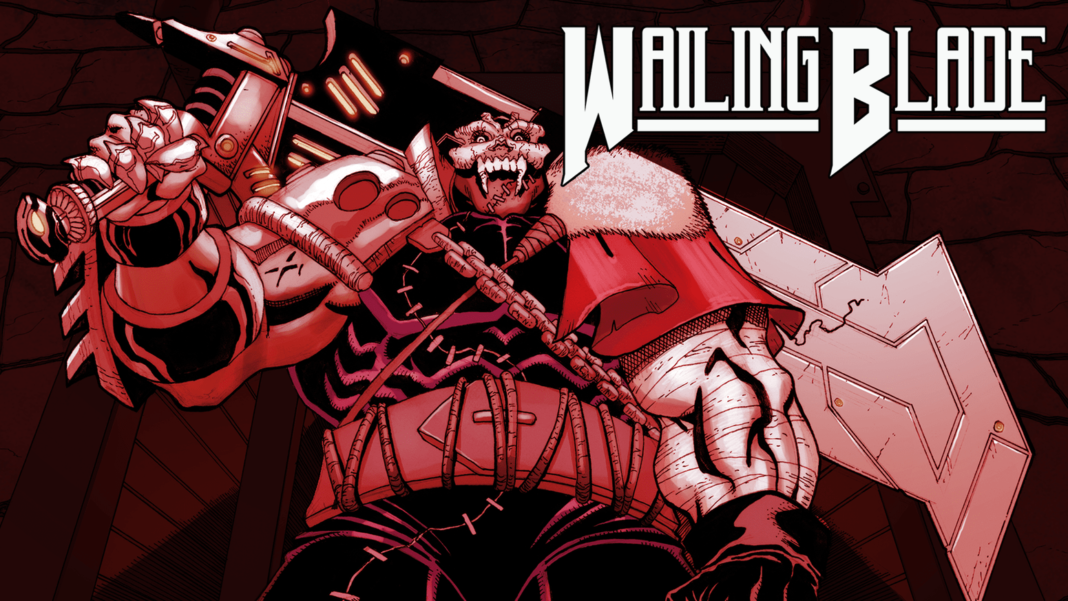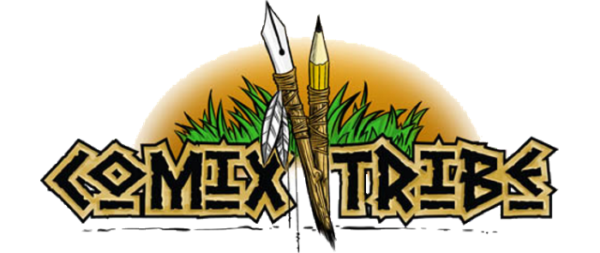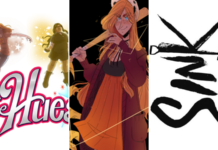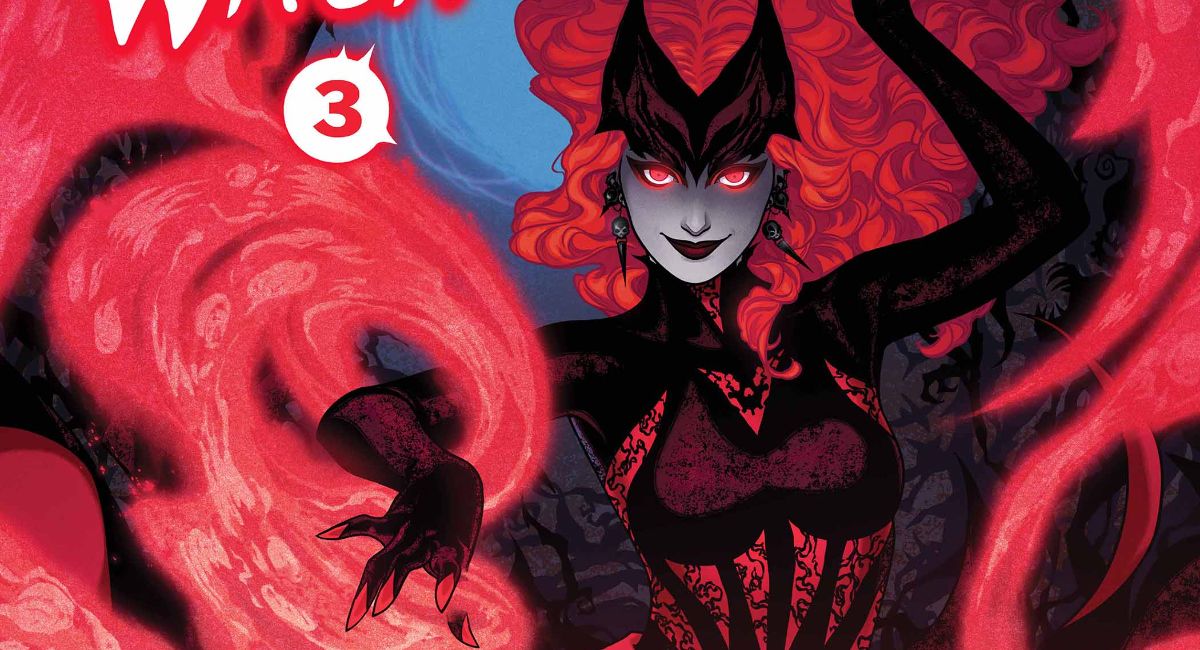Tyler James is one of the hardest working people in comics. He’s the publisher of ComixTribe, which is responsible for indie hits And Then Emily Was Gone and The Wailing Blade, among others. Tyler also runs ComixLaunch, which consists of a podcast and a series of courses specifically about crowdfunding comics. He’s proved his expertise through his 17 successful Kickstarters for ComixTribe projects and C is for Cthulhu, a brand built off of the Lovecraft Alphabet Book. I was pleased to interview Tyler about his many businesses and how ComixTribe has taken advantage of all the different ways to sell comics.
Can you provide an update on ComixTribe? What’s been exciting for the publisher lately?
Sure thing, Matt, thanks for the opportunity!
As far as exciting stuff, there’s always something cool cooking over here.
As far as what’s the latest, after several years of development, our new series WAILING BLADE finally released in the last month and set a new high-watermark for comic book sales for a new ComixTribe series. The dark sci-fi fantasy series created by writer Rich Douek (Road of Bones) and Joe Mulvey (SCAM) and rounded out by color artist Chris Sotomayor & letterer Taylor Esposito really resonated with our fans.
Note: To check out WAILING BLADE #1 for free, go to ComixTribe.com/taketheblade
Additionally, the crime horror series SINK is about to enter double digits, and the crack team of writer John Lees and artist Alex Cormack, at this point, are a well-oiled comic making machine. We’re gearing up to launch the collection for the second volume of SINK: Blood & Rain, and the team is working on exciting plans for the future of that series and the characters within it.
We just launched our 7th successful Kickstarter C is for Cthulhu brand, this time with a project funding GLOW-IN-THE-DARK Cthulhu plush toys. Had you told me ten years ago that I’d be publishing horror-themed children’s books, I wouldn’t believe you. But now that I have a 16-month-old at home (who does some modeling for us) I’m really glad we have this side of the business fully operational.
Is ComixTribe your full-time job, or is it a passion project on the side?
I’ve been working full-time as ComixTribe publisher since the end of 2016. Prior to that, it was a passion project / side-hustle that I built from 5 to 9, while working a 9 to 5 in as a senior game designer for an educational software company.
Now, my work with ComixTribe revolves around three core brands. First, the ComixTribe comics and graphic novel publishing line. Second, the C is for Cthulhu brand. And the third is ComixLaunch. Since 2015, I’ve been saving writers, artists, comic creators and publishers from disappointing crowdfunding launches by sharing the mindset, strategies and tactics to successfully fund projects on Kickstarter and beyond.
Through the free ComixLaunch podcast and my premium ComixLaunch Pro courses, creator communities, and masterminds, I’ve helped hundreds of creators raise hundreds of thousands of dollars to bring their dream projects to life.
I do what I love and I love what I do (and have the coffee mug to prove it), and every day I get to do this is an absolute gift.
Compared to previous years, how healthy is comics crowdfunding in 2019?
Never been better!
Kickstarter announced that 2018 set a Kickstarter record for comics funding on the platform.
Furthermore, the success rate for comic book projects specifically has gone through the roof, and was at an all-time high last year, and has continued to climb in 2019.
I started the ComixLaunch podcast almost four years ago because, at that time, more than half of all comic projects on Kickstarter failed.
In the time since, I’ve monitored the overall success rate of projects on Kickstarter closely, and the success rate for comics projects specifically have steadily kept rising, while the overall Kickstarter success rate and virtually every other category on Kickstarter have remained flat or declined.
The comics community is special.
And even cooler, the creators who work with me inside ComixLaunch Pro and follow my systematic, step-by-step approach for Kickstarter success found in my flagship program The ComixLaunch Course, are funding at a 95% success rate.
While I am a strong Kickstarter proponent, it’s also cool to see that there are several comic projects that have done very well on Indiegogo as well. Competition between platforms and having viable crowdfunding options is definitely a good thing.
So, if you’re a comic book creator with a big dream and an awesome project and the only thing holding you back is funding, well, there’s never been a better opportunity to get that funding through the power of crowdfunding than 2019.
I put together a new free Kickstarter strategy guide for creators interested in learning some savvy things that are working right now for both first time and veteran creators. That’s available at ComixLaunch.com/funded for anyone interested in adding a few new tricks to their arsenal.
How has crowdfunding transformed ComixTribe?
There’s pre-Kickstarter and there’s post-Kickstarter… and everything people know about ComixTribe happened post Kickstarter.
Prior to Kickstarter, I had never printed more than 100 copies of a book at time. Today, we’ve printed several hundred thousand total books.
Prior to Kickstarter, we had no distribution. Today we have worldwide distribution through a number of sales channels.
Prior to Kickstarter, the only real source of revenue for ComixTribe was conventions… which didn’t amount to much after factoring product, tabling and travel costs.
Prior to Kickstarter, there really wasn’t much interest in anything that I or the creators I publish created. Today we’ve had our books translated into four foreign languages and a number of ComixTribe properties have garnered interest for adaptation into film & tv. (Not holding my breath or anything, but I have no doubt in my mind that you’ll eventually see something that first graced the pages in a ComixTribe book on the screen.)
Kickstarter lived up to its name, as far as ComixTribe is concerned… it Kickstarted everything for us.
Running a number of crowdfunding campaigns has the potential to result in stagnation. What’s the key to keeping Kickstarter a regular part of your business model?
Funny, I was having this conversation with a creator in my Mastermind the other day. The truth is that when you notch that very first Kickstarter launch… it’s an incredible feeling. Many indie creators I work with will make more on their first Kickstarter launch than they’ve made in their entire careers up until that point. It feels almost like magic. Fast forward to your 5th, 10th, or in my case 17th launch… and it can be a bit harder to get up for a launch.
Though I’ve never run one, I’d imagine it’s similar for a marathon runner. Finishing your first marathon inevitably feels like a different accomplishment than your 15th!
Once I realized that Kickstarter would be a key component of ComixTribe’s business model, I moved to systematize everything I do that works in a launch, which has allowed me to have repeated success for different projects, in different genres and for different markets. It’s also allowed me to teach that system to other creators… and learn and refine it over time.
I sound like a dead record, but every launch is a learning opportunity and I learn something new every time I launch a Kickstarter project. So that’s one key to avoid stagnation… to follow a system of success, but also look for new things to test and try out so that you can learn something.
One of the big shifts for ComixTribe over the past few launches is that we’ve radically reduced the length of our Kickstarter launches, without reducing the total amount of funding raised. Everyone who has launched a Kickstarter has experienced the dreaded “dead zone” or long middle stretch of a campaign, which can be emotionally draining. Reducing the length of our campaigns has cut out a big chunk of the dead zone, and allowed us to fit more launches into the calendar year, without adversely affecting our bottom line.
How do ComixTribe’s earnings break down between Kickstarter, the Direct Market, and other sources of revenue?
One of the things that ComixTribe has been known for since day one is transparency, so happy to talk some numbers with you, because I think it illustrates a number of interesting points in today’s market.
Let’s talk about launching a new series into the comic book industry, and let’s use WAILING BLADE #1 as an example.
This is a book that we’re currently selling through six distinct sales channels:
- The Direct Market (Diamond)
- Kickstarter
- Conventions/ Signings
- Our Online Shop (Shop.ComixTribe.com)
- Comixology
- Direct to Retail Sales
One thing you’ll notice about the book if you take the time to flip through it is that there is literally NOTHING indie about WAILING BLADE from a production value perspective, and that’s because the creative is legit.
We actually leaned into that as one of the strengths in our Kickstarter campaign and called out the impressive credentials of the team behind this book.
But, let’s be honest, a book that looks like this is not inexpensive to produce, and the reality is if we had to rely on any one of the above sales channels to support the book… it would be impossible to support the book.
In terms of numbers, for ComixTribe, Wailing Blade #1 had very strong orders.
To date, we’ve sold 4,381 copies to Diamond for direct market distribution. (For those of you checking our numbers at Comichron.com, note that those numbers did not include the two re-orders we’ve received after Diamond sold through its initial order.)
On a $4.99 book, sold to Diamond at 60%-off cover price, that puts total Diamond sales revenue at around $8,744.
Now, back in January, we launched a Kickstarter campaign to help fund the first issue along with a whole host of cool variant covers not sold through Diamond and some awesome collectibles.
$16,257 were pledged to that campaign, and after dropped pledges and Kickstarter fees, we received $14,520 in sales revenue via that sales channel.
Conventions and Signings are a mixed bag. Joe and Rich have been ramping up their appearances and will sell sketches and books there, which isn’t really factored into my publisher numbers. As a publisher, I’ve throttled my own convention attendance down significantly, but ComixTribe will still do a few shows every year and might expect to sell a few hundred dollars worth of WAILING BLADE #1 direct to fans in this way.
While we’ve throttled down our conventions over the past few years, we’ve definitely enhanced our online sales ability at Shop.ComixTribe.com, and have done about $3,000 in online sales for WAILING BLADE #1 and related products since the book’s release.
Comixology, as a platform, is pretty flat for us. We won’t know how WAILING BLADE #1 performed over there for a few more months, but I’d be surprised if it results in more than a few hundred dollars in sales.
And last, but certainly not least, is direct to retail sales. In addition to selling books direct to retailers, who sometimes contact us directly at [email protected] to get books faster than Diamond can restock or buy ComixTribe exclusive variants from us, we do have several retailers, collector groups and in one case now an artist, interested in partnering up for exclusive covers, for win/win/win scenarios.
We partnered up with artist Franck Uzan, who did an exclusive cover for the book and then bought several hundred copies to sell directly to his fans and at conventions.
And Larry’s Comics commissioned Alex Cormack (SINK, Road of Bones) to do a Hulk #340 Homage cover.For WAILING BLADE #1, direct to retail sales in this fashion have added another $3,000 or so to the revenue mix.
Now, it should be noted that our costs for the publication of this series are a lot higher than simply printing the books. Marketing expenses, shipping and fulfillment expenses, and the cost of production of some premium products (enamel pins, prints, collector’s boxes, etc) mean there’s no shortage of things to use that revenue on. But as you can see, having a multi-channel approach really does give us the ability to generate significantly more overall revenue and serve a wider array of comic fans than were we to rely on any single channel exclusively.
Is being carried through Diamond and available at comic shops important to ComixTribe on a symbolic level as well as a financial one?
It definitely is.
Comic book retailers are still on the front lines of this industry.
For some fans and collectors, a book isn’t “real” until it’s been released in the direct market and that means Diamond.
And for the creators I publish with aspirations of also getting work-for-hire gigs with top publishers, coming out on a Wednesday with a “real” comic release is important to them.
Furthermore, getting a series optioned for film/tv, getting a formal release will get your books on the radar of far more people in Hollywood and beyond that if it’s just floating out there along with everything else on the internet.
And as you can see, we move the most units through the direct market and it is our second highest revenue generating channel.
What I think is interesting and perhaps counterintuitive is that our two series that sold the most in the direct market, WAILING BLADE and SINK, were both series that were available on Kickstarter first. Rather than reduce direct market demand, it’s enhanced it.
One of the most common pieces of advice I give to creators is to get out of the world of “this OR that” thinking and instead consider a “this AND that” approach. It’s served us well.
Have you found sharing advice on making comics to result in stronger sales and/or more loyal customers?
Definitely. In the early days, our campaigns and books and convention sales were supported by a higher than usual number of fellow creators, who got value from the resources we put out into the world. But even the casual fan, without any creative aspirations of his or her own, love the opportunity to be pulled in behind the curtain.
Do you hope to increase ComixTribe’s output over time or do you prefer to limit the number of new releases?
Our strategy has been to focus on one or two series at a time and make sure we’re putting out books that go to the very top of people’s pull lists, rather than just another book in the pile.
One of the things I hope I can report back on the next time we chat is that I’ve built out the ComixTribe support staff so that we can put out more titles, without the quality suffering.
Different publishers have very different goals. How does ComixTribe define success?
Great question. I probably should have this defined and hung on the wall in front of me! Success is putting out books we believe in, that our readers absolutely love, profitably and sustainably, made by dedicated and extremely talented storytellers who get better with every new release. That sounds pretty good to me!
Follow Tyler James on Twitter @TylerJamesComic and check out more from ComixTribe and ComixLaunch.





















